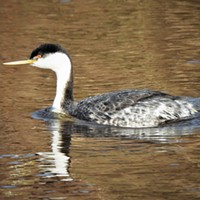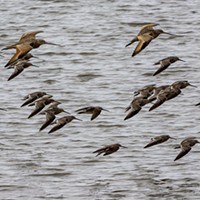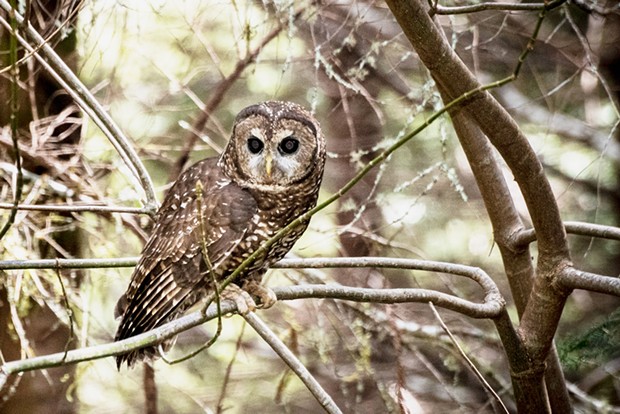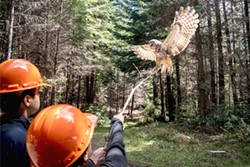[
{
"name": "Top Stories Video Pair",
"insertPoint": "7",
"component": "17087298",
"parentWrapperClass": "fdn-ads-inline-content-block",
"requiredCountToDisplay": "1"
}
]
After four decades of hiking in Humboldt County forests, I'd never spotted a wild northern spotted owl (Strix occidentalis) until Saturday during a Godwit Days tour, thanks to help from a tour guide and an assist from a white mouse. My wife and I did see a barred owl (Strix varia) a couple years ago on the Ossagon Trail in Redwood National Park (more on the "invasive" barred owls later).
To fill in this gap in my birding life list, I had signed up for a recent guided Godwit Days outing to a forest owned by the local Green Diamond logging company. It seems I was not the only Godwit Days attendee looking to see a wild spotted owl in Humboldt as I got the last open spot in one of the two weekend owl-watching tours.
Saturday proved to be a lovely day and I joined a diverse group of 20 birdwatchers of all ages and our tour guide at the Arcata Community Center. While waiting, we looked over the spotted owl painting hanging on the nearby wall by third grader Margo Nims, of Garfield Elementary, who won the "Best Bird in Habitat" award in the annual Godwit Days painting contest.
Our tour guide and Green Diamond employee James Lucchesi offered directions for carpooling to our meet-up place in Korbel across the road from North Fork Lumber Co. After gathering in a circle, Lucchesi held an informative talk and lively Q&A session about the spotted owl's breeding habits (typically only one chick every year or two), its preferred habitat (old growth forests), food preferences (mostly wood rats), its endangered species status ("threatened") and why Green Diamond and other timber company employees like himself spend a lot of time seeking out spotted owls and their nesting locations.
The owl's endangered status and declining numbers, Lucchesi explained, are due to loss and degradation of its preferred habitat, old growth forests. In June of 1990, after years of negotiation and litigation between the government, environmentalists and the timber industry, the northern spotted owl was listed as threatened under the Endangered Species Act; since then, population numbers have continued to decline.
As a result, according to the National Park Service, northern spotted owls have been called an "indicator" species because their presence in a forest is a gauge of the ecological health of the habitat. If you can find an area with a spotted owl, then the location is likely able to support a diversity of other plants and animals. Indicator species are often the first in their ecosystem to be affected by a particular environmental change, such as a warming climate, pollution, human development and other types of environmental degradation.
As a result of the owl's threatened status, Lucchesi's job is to search for spotted owls and their nesting sites on Green Diamond forestlands within its proposed timber-harvest plans. If owls are found, the company must come up with mitigation plans to protect the owl habitat and nest sites.
A tour member next asked Lucchesi about a relatively recent new threat to spotted owls: the increasing number of "invasive" barred owls moving into northern spotted owl territories in the Pacific Northwest including Humboldt County forests. Barred owls are a native species to eastern North America and began expanding their range westward since the early 1900s.
According to U.S. Fish and Wildlife Services research, barred owls' rapid increase in numbers (they produce more chicks per year than spotted owls) is the primary factor "negatively affecting apparent survival, recruitment and ultimately, rates of population change of spotted owls. Without removal or reduction of barred owl populations, it's likely northern spotted owls will become locally extinct from portions of their range."
Somewhat reluctantly, Lucchesi said "reduction" of barred owl populations using a 12-gauge shotgun is now one of his latest job assignments as part of research experiments in local forests where spotted owls live. He described ethical and other challenges he faces with this task and said the research conclusions about the utility of the killing experiments are still pending. He said while it's still early, it appears nesting success has increased for spotted owls in some experimental locations where barred owl numbers have been reduced.
I asked Lucchesi if he'd observed any evidence of cross breeding between barred owls and spotted owls. He confirmed a few sightings and said it appears mostly to have occurred between a male spotted owl and a female barred owl, and he had a funny explanation as to why. Barred owls are omnivores, unlike the spotted owls, and a male barred owl would likely get swiftly rejected by a female spotted owl if it offered her a food offering other than a wood rat. But male spotted owls bringing wood rats to female barred owls would likely be welcomed.
It was soon time to don our hard hats and drive up to where a spotted owl and a box of white mice were waiting. Lucchesi had sent a colleague up earlier to scout a location where they had seen a spotted owl many times before — and we soon learned this spotted owl was quite familiar with seeing humans in hard hats carrying small boxes containing white mice.
Early on, researchers looking for spotted owls trapped wild mice and used them to lure the owls. That took a lot of time and effort, so readily available white mice soon became the "bait," as they're cheap and easy to breed and raise.
And then I saw my first spotted owl. Lucchesi pointed out to us where the spotted owl was perched in a tree 50 feet away, well hidden in the shade, with the pattern of its plumage providing excellent camouflage. We barely had time to get the lens caps off our camera lenses before the owl silently swooped in over our heads and returned to its perch — even before a white mouse was taken out of the box.
As we readied our cameras, volunteers were asked to help hold up a branch as Lucchesi placed a lively white mouse on it. The owl quickly flew directly toward the mouse, grabbed it with its talons and flew back to its perch in a tree to eat it. The owl didn't seem concerned about whether the white mouse was free-range and organic.
After yet another mouse on a branch lured the owl in for another close look, it flew away into the woods. Lucchesi and his colleague then played sound recordings of spotted owl vocalizations to try to lure it back, but without success. Then it was time for us to head back home and to the Godwit Days banquet, excited to add the owl to our life list.
Mark Larson (he/him) is a retired Cal Poly Humboldt journalism professor and active freelance photographer who likes to walk.
Speaking of...
-

Godwit Days
Apr 6, 2023 -

Godwit Days Are Here Again
Apr 15, 2021 - More »
more from the author
-
The Sawdust Flies at the Conclave
- Mar 21, 2024
-
Once More into the Bay for the Perilous Plunge
- Mar 14, 2024
-
Photos: Humboldt Marble Weekend
- Feb 14, 2024
- More »

































